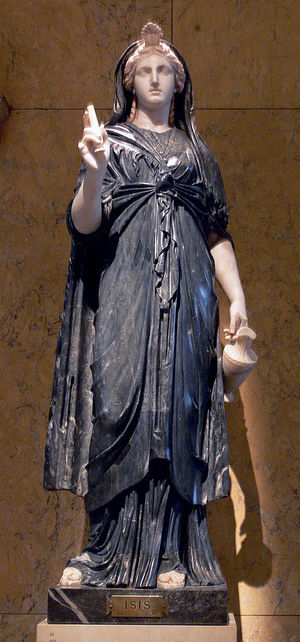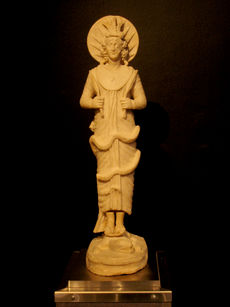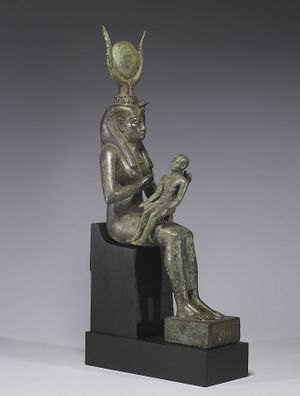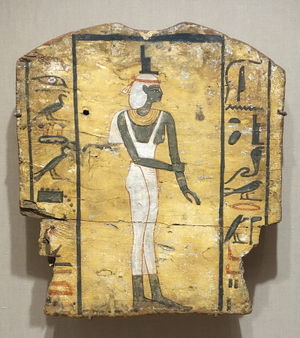Isis

The Egyptian goddess Isis is one of the most widely revered and sublime figures of the Divine Mother in ancient Mediterranean civilization. Texts written as far back as the third millennium B.C. speak of the divine couple Isis and Osiris. In the Hellenistic period, the worship of this ancient Mother of the Nile spread from its cradle in Egypt and Ethiopia throughout the area of the Mediterranean. In later centuries the worship of Isis stretched to every corner of the Roman Empire, where it became a major religion. Traces of the religion of Isis have been found as far east as Arabia and Asia Minor and as far west as Portugal and Britain.
En la antigua ciudad de Saïs en el delta del Nilo estuvo situado el templo de Isis. Conocida por miles de nombres, Isis se encuentra en las culturas del mundo. Conocida por cualquier nombre, ella es la Madre Divina que anima a toda Vida. Es ella quien dio a luz a todas las cosas, incluyendo al Hijo unigénito de Dios. Ella es siempre la Virgen Cósmica; porque la Madre Divina preserva la Visión Total de la Deidad y mediante la percepción del Ojo de Dios en la frente de ella, aparece el Cristo victorioso.
Attributes of Isis
Revered by emperor and slave alike, Isis was all things to all men. She was not only the Mother of all nature but also the source of every living thing, calling herself “the Lady of the House of Life.”[1] The Egyptians wrote of their all-powerful Divine Mother: “In the beginning there was Isis, Oldest of the Old. She was the Goddess from whom all becoming arose.”[2]
Isis was also the divine healer and the inventor of all, the creator of laws, champion of justice, and destroyer of despots, the embodiment of Divine Wisdom and Philosophy, and—last but not least—the ideal wife and mother.
Isis was to the whole human race profoundly affectionate, compassionate and loyal. Author R. E. Witt writes:
In the Graeco-Roman world Isis came to win the unswerving love and loyalty of countless men and women of every rank. Her names were infinite and her wisdom immeasurable. She did not allow room for any quarrel between science and religion,... for racial discrimination and segregation according to the color of one’s skin.[3]
The original Egyptian hieroglyph of the name Isis resembles a chair or throne. Scholars believe that this was meant to convey that every king arose from, or was born of, the throne—that is, Isis—the mother and protector of all pharaohs. During four thousand years of Egyptian history, all the pharaohs called themselves “sons of Isis.” The pharaohs were considered to be incarnations of Horus, the son of Isis, and the people believed that Isis lovingly nurtured their rulers just as she had her own son.
As recorded in Egyptian texts, one of Isis’ special attributes was her ability to perform miracles by using “words of power.” Thus, we find among the long list of her titles that of “Lady of Words of Power.” E. A. Wallis Budge explains that
Isis not only used the words of power, but she also had knowledge of the way in which to pronounce them so that the beings or things to which they were addressed would be compelled to listen to them and, having listened, would be obliged to fulfill her behests....
In the Hymn to Osiris ... it is said that Isis was well skilled in the use of words of power and it was by means of these that she restored her husband to life.[4]
In one episode in the Egyptian text called the Book of the Dead, Isis—acting as the Mother in fierce defense of her child—performs a ritual of exorcism to save her poisoned son, Horus. In the midst of her commands which are intended to drive the poison out of her son, Isis proclaims: “I am Isis the goddess and I am the lady of words of power, and I know how to work with words of power, and most mighty are my words!”[5] Her exhortations have the intended effect of healing her son and, as the text notes: “heaven was satisfied with the words which the goddess Isis” had spoken.[6]

The mysteries of Isis
Isis is also depicted as the discoverer of the mysteries of birth, life and death, and is therefore regarded as being preeminently wise. The fifth-century Greek philosopher Proclus wrote that a statue of Isis bore the following inscription characterizing her knowledge of the mysteries: “I am that which is, has been, and shall be. My veil no one has lifted. The fruit I bore was the Sun.” The phrase “to lift the veil of Isis” has come to mean “to penetrate the heart of a great mystery.” It is the Divine Mother who reveals to us the mysteries of Christ.
In about 300 B.C., there developed along with the popular religion of Isis a mystery teaching involving initiations into sacred rites and inner wisdom which Isis herself was said to have established based upon her own path of initiation. C. J. Bleeker writes:
According to the official doctrine, Isis herself had instituted the mysteries. In a great hymn in which she enumerates her virtues, she declares, “I taught people the mysteries.”
Plutarch discloses the motives for this deed. “When [Isis,] the sister and the wife of Osiris, as his avenger, had tempered and extinguished the fury of Seth [who had murdered her husband], she desired that the struggle, the danger and the wanderings which she passed through, being so many acts of courage and wisdom, should not be forgotten.
“Therefore, she wove into the most secret mysteries the images—indications of previous sufferings—and she instituted a doctrine of piety and a consolation to men and women who find themselves in the same misfortune.”
The last sentence is particularly noteworthy in that it reveals a side of the character of Isis which in that age became more and more prominent. She is a savior goddess, serving as a comforting example to the faithful in distress. She is able to redeem because she herself, through the courage with which she bore her suffering, had once obtained salvation.[7]

The figure of the Mother
As in many of the figures of the Divine Mother East and West, Isis embodies both the principle and the person of the Mother. That personal presence comes as the teacher and initiator on the one hand and the comforting presence of love on the other. R. E. Witt, summarizing the many faces of Isis, writes:
Isis, by identification with the Mother of the Gods, became without question the Life Force, indwelling Nature, wherever she gained adherents.... We find Isis praised with the awe and wonder by Apuleius as Venus ... by Lucretius for giving life to all things dwelling in the air, amid the sea and on the ground, fauna and flora. Her power controls the winds, the seasons, and the revolutions of the heavens. From her springs the light of the sun....
On a more personal level, writes Witt, Isis is “the acknowledged champion of those who most direly need help. At times of greatest hazard she steps in when all natural means of rescue seem impossible....
In the list of her praises from the Oxyrhynchus Litany we read in the succession the titles “giver of favours,” “gentle” and “affectionate”; yet she is afterwards magnified as one to whom “the spirits” (the demons, or “the elements”) have to show obedience.
True to the tradition of her native Egypt, where the peasant in the fields was never idle, Isis toiled without rest on behalf of her beloved human family, sheltering them on land and sea, banishing the storms that beset their lives, and stretching out to them the strong right hand of a Saviour....
Certainly, Isis gives her children the sure hope of eternal salvation: but in return she demands of them unquestioning, even blind obedience, just as she subjects them to the most gruelling tests before they reach the haven of their rest....
The faithful must sometimes toil for long without reward before the everlasting arms of their Mother are suddenly reached out to rescue them.... She is in the fullest sense Love.[8]

The identity and purpose of the Divine Mother
En el libro de Erman Handbook of Egyptian Religion (Guía de la Religión Egipcia), encontramos ciertas declaraciones atribuidas a Isis, la personificación del aspecto Femenino, que rememora la identidad y propósito de la Madre Divina. Éstas son importantes porque dan evidencia de la continuidad de las enseñanzas de la Hermandad acerca de la llama de la Madre desde tiempos antiguos hasta el presente:
Yo soy Isis, dueña de toda la tierra:
La Madre Tierra toma dominio sobre todo el universo físico.
Fui instruida por Hermes,
El Dios de la Ciencia ordena a la Madre que enseñe a la humanidad las leyes que gobiernan el plano de la manifestación material.
y con Hermes inventé las escrituras de las naciones, para que nadie escribiera con las mismas letras.
La comunicación de las ideas de Dios y la identificación mediante la Palabra escrita y hablada es el proceso por medio del cual la Madre hace inteligible a sus hijos la conciencia del Padre.
Yo le di a la humanidad sus leyes y ordené lo que nadie podía alterar.
Los mandamientos del SEÑOR y las leyes que gobiernan la emanación de energía del Espíritu a la Materia, indispensables para el bienestar del hombre, son la expresión inalterable del Espíritu en la Materia.
Yo soy la hija mayor de Kronos.[9]
Aunque la Madre encarna la conciencia del Padre en el plano de la tierra Material, sus energías vienen del plano de la tierra Espiritual.
Yo soy esposa y hermana del Rey Osiris.
Al referirse a las diosas femeninas como esposa, hermana o hija de los dioses, los antiguos indicaban la polaridad que existe entre el aspecto yang y el yin de la creación. Isis es la llama gemela de Osiris; juntos en su esfera designada, ellos coordinan las funciones de Alfa y Omega.
Yo soy la que sale de la estrella del can.
La imagen de la Madre Divina se ve en la Estrella Divina Sirio, foco del Gran Sol Central en este sector de nuestra galaxia.
A mí me dicen la diosa de las mujeres...
La Madre del Mundo representa a Dios en la Mujer.
Yo soy la que separó el cielo de la tierra.
Con la creación de la Materia la Totalidad divina se dividió en dos.
He enseñado su sendero a las estrellas.
La Madre delinea el destino de sus hijos e hijas y les imparte la sabiduría y el amor necesarios para cumplir su plan original divino.

Yo he inventado la navegación...
La Madre, frecuentemente llamada la Estrella del Mar, es la dueña de los mares—ya que el agua es el aspecto más femenino, o yin, de la creación material.
He unido a los hombres y a las mujeres...
El aspecto del amor de la Madre Divina es la fuerza cohesiva de átomos, universos y llamas gemelas.
He ordenado que los ancianos sean amados por los niños.
Mediante la Madre se preserva la continuidad de la llama de la vida, la cultura y el arrobado reconocimiento del Padre—de una generación a otra.
Con mi hermano Osiris trajimos el fin del canibalismo.
Por medio de la Madre, el hombre llega a comprender la necesidad de tener reverencia por la Vida, por el Dios que habita en Su creación.
He instruido a la humanidad acerca de los misterios.
La Sabiduría enseña a sus hijos las reglas geométricas del Espíritu del SEÑOR.
He enseñado la reverencia por las estatuas divinas.
Como la estatua es el símbolo de la identidad de Dios individualizada en Su manifestación, así también toda manifestación es la encarnación del Principio del Cristo Universal. Es ante éste, en vez de ante la estatua o la persona que doblamos la rodilla y dirigimos nuestra devoción.
Yo he establecido los recintos del templo.
La Materia es el templo del Espíritu y forma las fronteras de ésta, guardando fervientemente la ley sagrada, la ciencia sagrada y la sagrada llama de la Vida.
He derrocado el dominio de los tiranos.
Las perversiones de la conciencia de Dios y de la Imagen del Padre son expuestas por la Madre Divina.
He hecho que los hombres amen a las mujeres.
La Madre es la contraparte del Imán Divino al atraer el flujo del Espíritu al vientre de la Materia.
He hecho a la justicia más poderosa que la plata y el oro.
Por el descubrimiento de la Imagen de la Madre reflejada en la Naturaleza, el hombre ya no está atado a la corporeidad como su fin, sino que percibe en las virtudes del Espíritu que salen del crisol del tiempo y el espacio, que el universo material sólo es el medio para alcanzar un fin; además reconoce que esas virtudes tienen el poder para tomar dominio sobre el espíritu humano, haciendo que se trascienda a sí mismo y al vehículo de barro que da morada al Espíritu.
He hecho que se considere bella a la verdad.[10]
La verdad, como la flecha de la conciencia del Padre, se hace bella en manifestación mediante la Imagen de la Madre.
Isis unveiled
Isis is the verb “to be” written twice: is-is. And so we see its link to I AM THAT I AM. “I AM THAT which is below, even as I AM that which is Above.”
Her statement, “I AM in Matter everything that has been and that is and that shall be, and no mortal hath lifted my veil,” could very well be the affirmation of Omega. The mysteries of creation were not entirely revealed, and because the Mother as the Shakti, as the Word itself, is not revealed, Isis has remained veiled.
Isis is the veiled goddess whom we do not know until that veil is parted, partially or totally, in moments of inner recognition and of a profound sense of oneness with this Universal Mother. The Divine Mother, Above and below reveals herself as God reveals himself. We see her first universally in the realm of Cosmos, of Spirit and spiritual realities. But how do we know God individually? How do we know Father and Mother individually?
The Gospel of John tells us, “The light shineth in darkness; and the darkness comprehended it not.... And the Word was made flesh, and dwelt among us, and we beheld his glory, the glory as of the only begotten Son of the Father, full of grace and truth.”[11] Jesus was the vessel for the universal God, the universal light as Father-Mother, as Christos, and that immensity apportioned to each one becomes the individual Christ, the individual I AM Presence and the individualized Mother.
Therefore, the unveiling of Isis was accomplished by Jesus. This is clearly seen when we understand that in the Hindu tradition the Word is always feminine, like the Shekinah in the Hebrew tradition. So the Word revealed is the light that when embodying in each one of us takes on the active nature and becomes manifest as action in this world. By good deeds, virtuous deeds, beneficent deeds, we reveal a whole scale of qualities of this light that is not comprehended except when it is individualized. Our reason for being, then, is to reveal who is the I AM dwelling in this temple and to unveil the Isis. This we do by our daily actions.
See also
Sources
Elizabeth Clare Prophet, April 17, 1988.
Mark L. Prophet and Elizabeth Clare Prophet, The Path of the Higher Self, volume 1 of the Climb the Highest Mountain® series, pp. 415–17.
Elizabeth Clare Prophet, November 29, 1981.
- ↑ R. E. Witt, Isis in the Graeco-Roman World (New York: Cornell University Press, 1971), p. 27.
- ↑ Merlin Stone, When God Was a Woman (New York: Harcourt Brace & Company, 1978), p. 219.
- ↑ Witt, p. 22.
- ↑ E. A. Wallis Budge, The Gods of the Egyptians: Or, Studies in Egyptian Mythology, Volume 2 (London: Methuen, 1904), p. 214.
- ↑ Ibid., p. 207.
- ↑ Ibid., p. 208.
- ↑ C. J. Bleeker, “Isis and Hathor,” in The Book of the Goddess: Past & Present, ed. Carl Olson (New York: Crossroad, 1987), p. 38.
- ↑ Witt, pp. 134–135, 137.
- ↑ Cronus, el dios de la tierra.
- ↑ Adolph Erman, Una guía de la Religión Egipcia, trad. A.S. Griffith (Londres: Archibald Constable & Co., 1907), págs. 244-245.
- ↑ John 1:5, 14.
